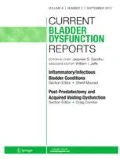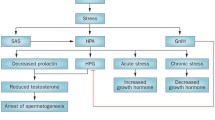Abstract
Psychological stress has long been suspected to worsen voiding dysfunction in men, but the possible causal relationship is poorly understood. Investigators have used many study methods, including observational studies and several prospective trials, intended to elicit psychological stress and then measure symptoms. Prostate growth is noted to decrease in animals that have undergone surgical sympathectomy, suggesting a role for the sympathetic nervous system in the growth of the prostate and not just in the contraction of its smooth muscle component. Prostate-specific antigen is noted to increase in men with poor social support and recent stress. Voiding parameters and prostate volume are also affected in patients with spinal cord injury. A growing body of literature relates stress to voiding dysfunction. Interest in this will likely increase as the knowledge base and understanding of the physiology improve.
Similar content being viewed by others
References and Recommended Reading
Lepor H: Alpha blockade for the treatment of benign prostatic hyperplasia. Urol Clin North Am 1995, 22:375–386.
Franciosi M, Koff WJ, Rhoden EL: Correlation between the total volume, transitional zone volume of the prostate, transitional prostate zone index and lower urinary tract symptoms (LUTS). Int Urol Nephrol 2007, 39:871–877.
Dib PT, Trigo-Rocha F, Gomez CM, Srougi M: Urodynamic evaluation in diabetic patients with prostate enlargement and lower urinary tract symptoms. Urol Int 2008, 80:378–382.
Eyres HM: Nervous retention of urine. Br Med J 1912, 1:484–485.
Melchior M, Caspi A, Milne BJ, et al.: Work stress precipitates depression and anxiety in young, working women and men. Psychol Med 2007, 37:1119–1129.
Spiegel D, Sephton SE, Terr AI, Stites DP: Effects of psychosocial treatment in prolonging cancer survival may be mediated by neuroimmune pathways. Ann N Y Acad Sci 1998, 840:674–683.
Cohen S, Doyle WJ, Skoner DP, et al.: Social ties and susceptibility to the common cold. JAMA 1997, 277:1940–1944.
Cohen S, Tyrrell DA, Smith AP: Psychological stress and susceptibility to the common cold. N Engl J Med 1991, 325:606–612.
Stone AA, Bovbjerg DH, Neale JM, et al.: Development of common cold symptoms following experimental rhinovirus infection is related to prior stressful life events. Behav Med 1992, 18:115–120.
Ahrens T, Deuschle M, Krumm B, et al.: Pituitary-adrenal and sympathetic nervous system responses to stress in women remitted from recurrent major depression. Psychosom Med 2008, 70:461–467.
Chrousos GP, Gold PW: The concepts of stress and stress system disorders. Overview of physical and behavioral homeostasis. JAMA 1992, 267:1244–1252.
Marshall I, Burt RP, Chapple CR: Noradrenaline contractions of human prostate mediated by alpha 1A-(alpha 1c-) adrenoceptor subtype. Br J Pharmacol 1995, 115:781–786.
McVary KT, Rademaker A, Lloyd GL, Gann P: Autonomic nervous system overactivity in men with lower urinary tract symptoms secondary to benign prostatic hyperplasia. J Urol 2005, 174:1327–1433.
Mills PJ, Ziegler MG, Patterson T, et al.: Plasma catecholamine and lymphocyte beta 2-adrenergic receptor alterations in elderly Alzheimer caregivers under stress. Psychosom Med 1997, 59:251–256.
Orsini N, RashidKhani B, Andersson SO, et al.: Long-term physical activity and lower urinary tract symptoms in men. J Urol 2006, 176:2546–2550.
Pannek J, Berges RR, Cubick G, et al.: Prostate size and PSA serum levels in male patients with spinal cord injury. Urology 2003, 62:845–848.
Suarez EC, Kuhn CM, Schanberg SM, et al.: Neuroendocrine, cardiovascular, and emotional responses of hostile men: the role of interpersonal challenge. Psychosom Med 1998, 60:78–88.
Tsigos C, Chrousos GP: Hypothalamic-pituitary-adrenal axis, neuroendocrine factors and stress. J Psychosom Res 2002, 53:865–871.
Ullrich PM, Lutgendorf SK, Kreder KJ: Physiologic reactivity to a laboratory stress task among men with benign prostatic hyperplasia. Urology 2007, 70:487–492.
Buss AH, Perry M: The aggression questionnaire. J Pers Soc Psychol 1992, 63:452–459.
Cohen S, Kamarck T, Mermelstein R: A global measure of perceived stress. J Health Soc Behav 1983, 24:385–396.
Sarason IG, Johnson JH, Siegel JM: Assessing the impact of life changes: development of the Life Experiences Survey. J Consult Clin Psychol 1978, 46:932–946.
Stone AA, Mezzacappa ES, Donatone BA, Gonder M: Psychosocial stress and social support are associated with prostate-specific antigen levels in men: results from a community screening program. Health Psychol 1999, 18:482–486.
Suarez EC, Sherwood A, Hinderliter AL: Hostility and adrenergic receptor responsiveness: evidence of reduced betareceptor responsiveness in high hostile men. J Psychosom Res 1998, 44:261–267.
Ullrich PM, Lutgendorf SK, Leserman J, et al.: Stress, hostility, and disease parameters of benign prostatic hyperplasia. Psychosom Med 2005, 67:476–482.
Crispo A, Talamini R, Gallus S, et al.: Alcohol and the risk of prostate cancer and benign prostatic hyperplasia. Urology 2004, 64:717–722.
Gatenbeck L, Johansson B, Stromberg L: Blood perfusion of the male genital organs—an experimental study in the rat. Urol Res 1987, 15:291–295.
Fitzpatrick J: Clinical perspective on apoptosis in the management of the BPH patient. Prostate Suppl 2000, 9:47–50.
Nakaki T, Nakayama M, Yamamoto S, Kato R: Alpha 1-adrenergic stimulation and beta 2-adrenergic inhibition of DNA synthesis in vascular smooth muscle cells. Mol Pharmacol 1990, 37:30–36.
McVary KT, Razzaq A, Lee C, et al.: Growth of the rat prostate gland is facilitated by the autonomic nervous system. Biol Reprod 1994, 51:99–107.
Bautista OM, Kusek JW, Nyberg LM, et al.: Study design of the Medical Therapy of Prostatic Symptoms (MTOPS) trial. Control Clin Trials 2003, 24:224–243.
Frisbie JH, Kumar S, Aguilera EJ, Yalla S: Prostate atrophy and spinal cord lesions. Spinal Cord 2006, 44:24–27.
Shim HB, Kim YD, Jung TY, et al.: Prostate-specific antigen and prostate volume in Korean men with spinal cord injury: a case-control study. Spinal Cord 2008, 46:11–15.
Frisbie JH: Statistics and the prostate gland. Spinal Cord 2008, 46:459.
Gass R: Benign prostatic hyperplasia: the opposite effects of alcohol and coffee intake. BJU Int 2002, 90:649–654.
Laumann EO, Paik A, Rosen RC: Sexual dysfunction in the United States: prevalence and predictors. JAMA 1999, 281:537–544.
Author information
Authors and Affiliations
Corresponding author
Rights and permissions
About this article
Cite this article
Powell, C.R., Kreder, K.J. Effects of stress on male voiding function. Curr Bladder Dysfunct Rep 4, 171–175 (2009). https://doi.org/10.1007/s11884-009-0024-0
Published:
Issue Date:
DOI: https://doi.org/10.1007/s11884-009-0024-0




